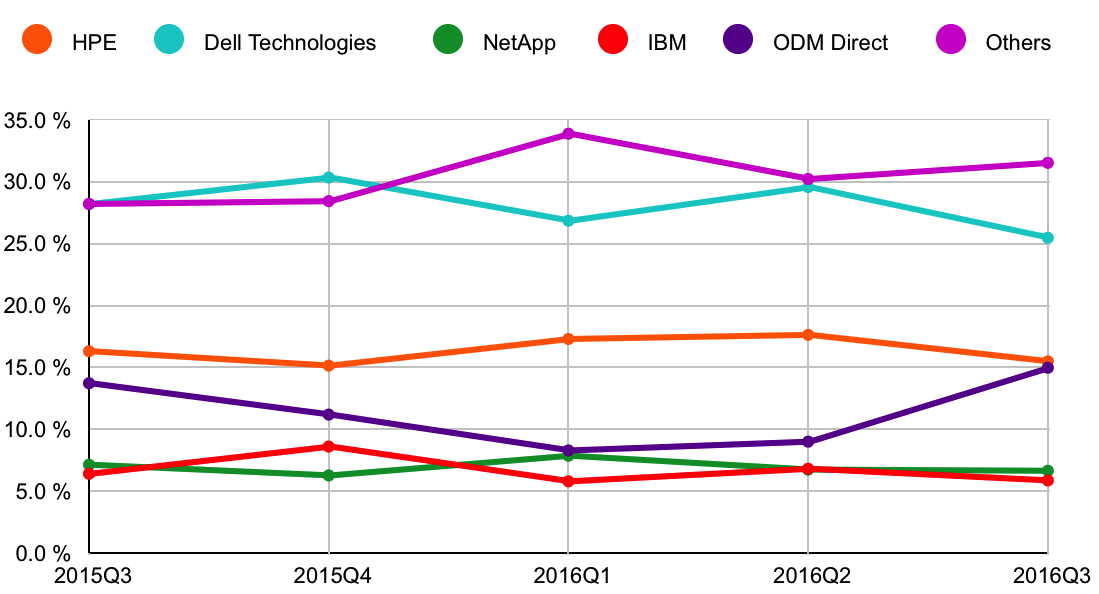WW Enterprise Storage Market Down 3% in 3Q16 From 3Q15 – IDC
One fourth for Dell EMC in revenue but down 13%
This is a Press Release edited by StorageNewsletter.com on December 5, 2016 at 3:01 pmTotal WW enterprise storage systems factory revenue was down 3.2% year over year and reached $8.8 billion in 3Q16, according to the IDC Worldwide Quarterly Enterprise Storage Systems Tracker.
Total capacity shipments were up 33.2% year over year to 44.3 EBs during the quarter.
Revenue growth increased within the group of original design manufacturers (ODMs) that sell directly to hyperscale datacenters. This portion of the market was up 5.7% year over year to $1.3 billion.
Sales of server-based storage were relatively flat, at -0.5% during the quarter and accounted for $2.1 billion in revenue. External storage systems remained the largest market segment, but the $5.4 billion in sales represented a decline of 6.1% year over year.
“The enterprise storage market closed out the third quarter on a slight downturn, while continuing to adhere to familiar trends,” said Liz Conner, research manager, storage systems. “Spending on traditional external arrays resumed its decline and spending on all-flash deployments continued to see good growth and helped to drive the overall market. Meanwhile the very nature of the hyperscale business leads to heavy fluctuations within the market segment, posting solid growth in 3Q16.”
3Q16 Total Enterprise Storage Systems Market, by Vendor
Dell Technologies held the number 1 position within the total W enterprise storage systems market, accounting for 25.5% of spending. HPE held the next position with a 15.5% share of revenue during the quarter. NetApp, IBM, and Hitachi finished in a statistical tie* for the third position, capturing 6.6%, 5.9% and 5.7% of global spending, respectively. As a single group, storage systems sales by ODMs selling directly to hyperscale datacenter customers accounted for 15.0% of global spending during the quarter.
Top 5 Vendor Groups, WW Enterprise Storage Systems Market, 3Q16
(revenue in $ million)
(Source: IDC Worldwide Quarterly Enterprise Storage Systems Tracker, December 2, 2016)
Top 5 Vendor Groups, WW Enterprise Storage Systems Market, 3Q15 – 3Q16
(based on revenue)
(Source: IDC Worldwide Quarterly Enterprise Storage Systems Tracker, December 2, 2016)
3Q16 External Enterprise Storage Systems Results, by Vendor Group
Dell Technologies was the largest external enterprise storage systems supplier during the quarter, accounting for 31.6% of worldwide revenues. NetApp and HPE finished in a statistical tie* for the number 2 position with 10.9% and 10.2% of market share, respectively. Hitachi and IBM rounded out the top 5 in a statistical tie* for the number 4 position with revenue shares of 9.1% and 8.6%, respectively.
Top 5 Vendors Groups, WW External Enterprise Storage Systems Market, 3Q16
(revenue in $ million)
(Source: IDC Worldwide Quarterly Enterprise Storage Systems Tracker, December 2, 2016)
* IDC declares a statistical tie in the worldwide enterprise storage systems market when there is less than one% difference in the revenue share of two or more vendors. Dell Technologies represents the combined revenues for Dell and EMC.
Flash-Based Storage Systems Highlights
The total All Flash Array (AFA) market generated over $1.1 billion in revenue during the quarter, up 61.0% year over year. The Hybrid Flash Array (HFA) segment of the market continues to be a significant part of the overall market with $2.1 billion in revenue and 24.1% market share.
Taxonomy Notes
- IDC defines a disk storage system as a set of storage elements, including controllers, cables, and (in some instances) HBAs, associated with three or more disks. A system may be located outside of or within a server cabinet and the average cost of the disk storage systems does not include infrastructure storage hardware (i.e. switches) and non-bundled storage software.
- The information in this quantitative study is based on a branded view of the disk storage systems sale. Revenue associated with the products to the end user is attributed to the seller (brand) of the product, not the manufacturer. OEM sales are not included in this study. Hitachi Data Systems sales do not reflect their OEM sales to Sun Microsystems and Hewlett-Packard.









 Subscribe to our free daily newsletter
Subscribe to our free daily newsletter

